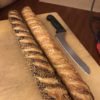This week, Brendan talked with self-professed food nerd J. Kenji López-Alt about his new book, “The Food Lab: Better Home Cooking Through Science.” It’s a thousand-page book on every food in the world… and how most people are cooking them wrong.
To start, Brendan asked J. Kenji where he got his food nerd bonafides.

J. Kenji López-Alt: Chief among my qualifications are that from the age of maybe 4 to 10 years old, I woke up every morning at 6 a.m. to watch “Mr. Wizard” on TV.
Brendan Francis Newnam: Yeah.
J. Kenji López-Alt: I literally learned every scientific concept from him by the time I was 10 years old.
Brendan Francis Newnam: Well, other nerd things you mention in the book are, you know, when you were stuck writing this book, you would look to Monty Python or science-fiction to kind of get inspired to keep going.
J. Kenji López-Alt: Yeah, my humor tends to the nerdy [laughs], I think.

Brendan Francis Newnam: So, that’s the funny part about being a nerd, but, you know, you also mean “nerd” — you take a scientific approach to things. At one point, you call cooking, “A scientific engineering problem in which the inputs are raw ingredients and technique and the outputs are deliciously edible results.”
J. Kenji López-Alt: Yeah, I worked in biology labs for a number of years and when in college. And you know, the work that I do in the kitchen is not all that different from the work you do in a Biology lab. You know, you start with a bunch of ingredients, you perform a set of processes on them, and then you end up with a result. You know, the difference is that cooking is A) generally much faster and B) a lot better tasting.
Brendan Francis Newnam: Than lab rats?
J. Kenji López-Alt: Yes [laughs]! Or gel electrophoresis plates, you know, things like that.
Brendan Francis Newnam: At another point you talk about, you know, one of the problems with cooking is that people view it as a craft, not a practice. But, I have to admit, I bristled a little bit because part of the reason I love the kitchen is because it’s not precise. It’s a little bit of this, a pinch of that. Have you gotten that reaction from other folks that you’re maybe ruining the magic by really distilling things down to these scientific principles?
J. Kenji López-Alt: I do get that and I cook that same way myself, but, the point is that understanding the basic techniques and scientific background of cooking, that actually helps you to improvise more. By understanding things, it sort of frees you from having to follow recipes.
Brendan Francis Newnam: So one of the things you do is you kind of give people the basic principles. You also end up correcting some misperceptions.
J. Kenji López-Alt: Mmhmm
Brendan Francis Newnam: One of them embodied in this story about Harold McGee…
J. Kenji López-Alt: A great food writer. He wrote “On Food & Cooking,” which is sort of the food-science bible. The thing you’re mentioning is the idea that searing meat seals in juices, which is something that was proposed, I think, in the 19th or 18th century.
It was believed for a long time, but since then it’s been debunked — including by Harold McGee about 20 years ago — but for some reason it’s one of those things that still seems to stick in people’s heads and you see chefs say it all the time, you see people on TV say it all the time that searing meat will seal in the juices.

Brendan Francis Newnam: And for people who don’t know, when you say “searing,” you just mean getting a raw steak and the idea was that you — and I heard this growing up, too — you cook it quickly on both sides and then you start to cook it for a longer period of time and the idea is that it would keep the moisture inside the piece of meat.
J. Kenji López-Alt: Exactly. Yeah, I think the idea is that you sort of cauterize the surfaces so that the moisture inside the meat can’t escape. But it’s pretty easy to disprove, actually. You take two identical steaks: One of them cooked the traditional way, so sear it really hard on a skillet and then transfer it to an oven to finish cooking a little more gently.
The second steak, do the reverse process. Start it in the oven, and then finish it by searing it. And you’ll find that the one you sear at the end actually retains more moisture and comes out more tender than the one that you did the traditional way.
Brendan Francis Newnam: I think your most popular thing you kind of corrected people on was eggs. Can you tell us your hard-boiled egg method?
J. Kenji López-Alt: The number one question I had when I was doing hard-boiled eggs was: What makes the peel stick to the egg sometimes? You know, sometimes you peel it and it comes off in one piece. Sometimes you peel it and it sticks, and egg white is fused to the shell.
For me, that’s a big issue, particularly because I used to have to make deviled eggs all the time in a restaurant I worked at and I would always end up at least doubling the number of eggs I cooked, knowing that a bunch of them are going to end up ugly. We ate a lot of egg salad for family meals those days.
What I found after testing was that the number one thing that makes a difference is the temperature of the water when you lower the eggs into it. So, some people recommend putting your eggs in cold water and then bringing that to a boil on the stovetop. That is the way that you’re going to get your eggs to stick the most. It’s much better to lower the eggs into hot water…

Brendan Francis Newnam: Good riddance, ugly eggs! So, what was something that really surprised you in the lab?
J. Kenji López-Alt: One of the biggest ones is pasta. I was always taught that you have to use a very large volume of water for the amount of pasta you’re cooking and there’s a couple of reasons given for this. One of them is that more water helps the pasta stick less. And the other one is that, with a larger volume of water, when you add the pasta to it, the temperature of that water drops less, and therefore, it returns to a boil faster, so you’re cooking the pasta faster.
But if you actually test it, side-by-side: Get yourself a gallon of water boiling in a big pot and a quart of water boiling in a smaller pot on the same strength burner, add the same amount of pasta to both pots and watch them, and you’ll find the smaller pot actually returns to a boil faster than the larger pot does.
Brendan Francis Newnam: So are there any mysteries you haven’t solved?
J. Kenji López-Alt: I’ve been trying to do homemade Chicken McNugget right now.
Brendan Francis Newnam: I have a theory that somethings are already done perfectly by other people.
J. Kenji López-Alt: Oh! I totally agree.
Brendan Francis Newnam: So, if you really want a perfect Chicken Nugget, get in your car and drive 10 minutes away and buy nuggets.
J. Kenji López-Alt: [Laughs.] No, but on the other hand, I think recreating fast food at home is just kind of a fun sort of little science experiment.
Brendan Francis Newnam: Spoken like a true nerd.


